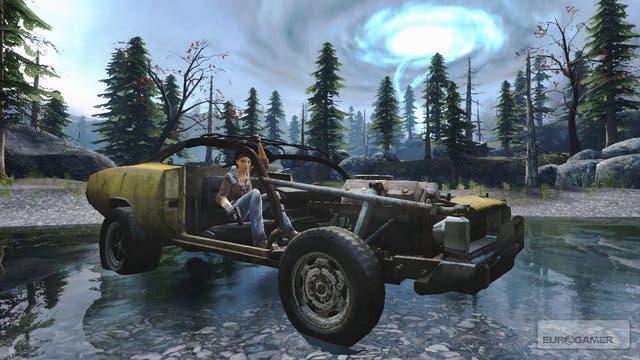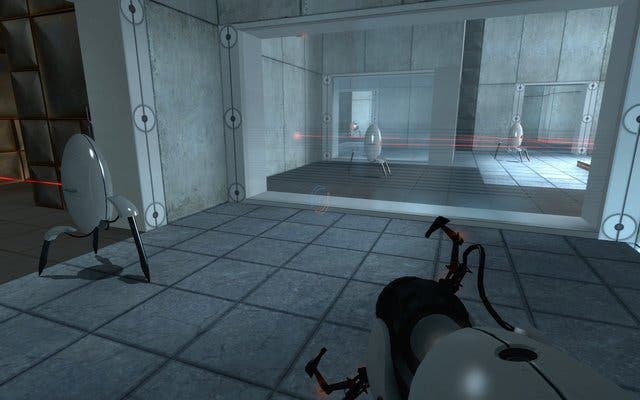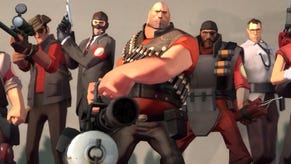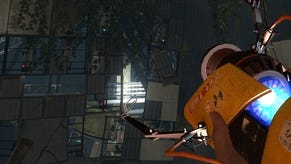The Orange Box
Bananas box, more like.
10th October finally saw the release of The Orange Box on Steam. What follows is a review of the product as a whole. For individual reviews of the component games, click on the following links.
- Half-Life 2: Episode Two review (PC, Xbox 360)
- Portal review (PC, Xbox 360)
- Team Fortress 2 review (PC)
Retail versions of The Orange Box are expected on 19th October for PC and Xbox 360. The PlayStation 3 version is currently undated, but expected soon. Anyway, read on!
Oh Valve, you're spoiling us. There are only two reasons why anyone with the kit or the means to pay for it would think of not buying The Orange Box. Number 1) You have some pathological aversion to first-person shooters, or, Number 2) You're a bit loopy in the head and like denying yourself the chance to play five of the best games ever released. Gaming masochism if you like. Go and play this if you want to know what real pain means.
Including the three constituent parts of Half-Life 2 in one box, then throwing in the incredible Portal and possibly the best team-based online FPS ever made in Team Fortress 2...it's easily the best value release anyone has ever come up with, and one so rammed with quality it's hard to comprehend. Even if you're one of the many people who have already played HL2 or Episode One, it represents such astonishing value that it ought to shock competing releases into shame.
If you're a 360 or PS3 owner who missed out on the delights of the 2004 original, then The Orange Box represents an amazing opportunity to get right up to date with one of the most beloved gaming series ever made. Three years might sound like a long time for us to still be raving about an old PC game, but Half-Life 2 wasn't any old PC game. Arguably one of the very first truly next generation titles, it still looks wonderful today, and, more importantly is a joy to go back to - even if you've played through it once or twice before.
Prog rock

True, not every chapter in Half-Life 2 is undiluted genius. Some sections feel over-long, others just a lonely set of corridors. But such moments in the context of a large game are pretty rare, and you'll come away with nothing but love for a game with so much variety and changes of pace that you won't mind letting Valve indulge in the gaming equivalent of the ten minute drum solo now and then.
With the arrival of each new enemy, and each new weapon, the flow of the combat totally changes the gameplay dynamic to the point that it almost feels like six different games, stitched together by an engrossing narrative which drives you on. Just as crucial to keeping the player wide-eyed and engaged is the way Valve throws beautifully contrasting environments at you. As gaming tourism goes, this is a one-way trip every self-respecting - or self-harming, we don't mind - gamer should play at some point.
It also makes perfect sense for Valve to throw Episode One into The Orange Box. Not only because it'd be a glaring omission not to include it, but because it's simply too short to release as a standalone episode on consoles. Clocking in at around four to five hours, its tightly constrained levels were a fantastic showcase for Valve's new co-op AI tricks, but it feels a tad claustrophobic after the wide, open spaces that characterised several sections of its forebear. Revisionist criticism aside, it's still excellent while it lasts, and packs in a succession of memorable set-pieces that are well worth a second run-through over an evening. Episode One also provides a more satisfying conclusion to "The City 17 adventures" than the cliffhanger ending of HL2.ever did. Admittedly the weakest part of The Orange Box, playing the 30-hour Half-Life 2 story chronologically is an enormously satisfying experience - if rather demanding back-to-back.
Death by Half-Life

But even if you've played through Half-Life 2 and Episode One to death, Valve's new Achievement system across all formats (but, realistically, most useful on the unified Gamerscore system employed by the 360) presents a surprising incentive to go back and play even the old stuff over again - but in a different way. For example, finding all 45 Lambda symbols in Half-Life 2 becomes a curiously important part of your quest, although with all five parts of The Orange Box sharing the 1000 gamerpoints, this isn't a game with which you can easily boost your total.
Free from the shackles of City 17 in Episode Two, it feels like a relief to be able to get back to nature - of sorts. More expansive than Episode One, and more tightly choreographed than Half-Life 2, it's the best of both worlds. Admittedly, the sense of familiarity can dull the game's appeal to a small extent, new enemies like the Acid Lions and the Hunters provide that all-important novelty factor. And as for the final, frantic chapter - well, it's worth the price of admission on its own.
On a personal level, probably my favourite part of the entire package is Portal. Building on the promise and startling originality of Narbacular Drop, it fleshes out the concept into something very special indeed. Rich with a surprising degree of warm humour, the way the game progresses from being a simple set of perfunctory tasks to a full-on part of the Half-Life story is absolute genius. Far from being the well-designed experiment that it initially appears to be, this is among the best games I've had the pleasure of playing this year.












